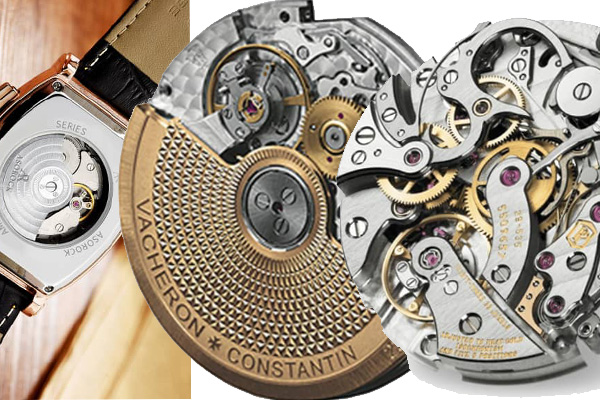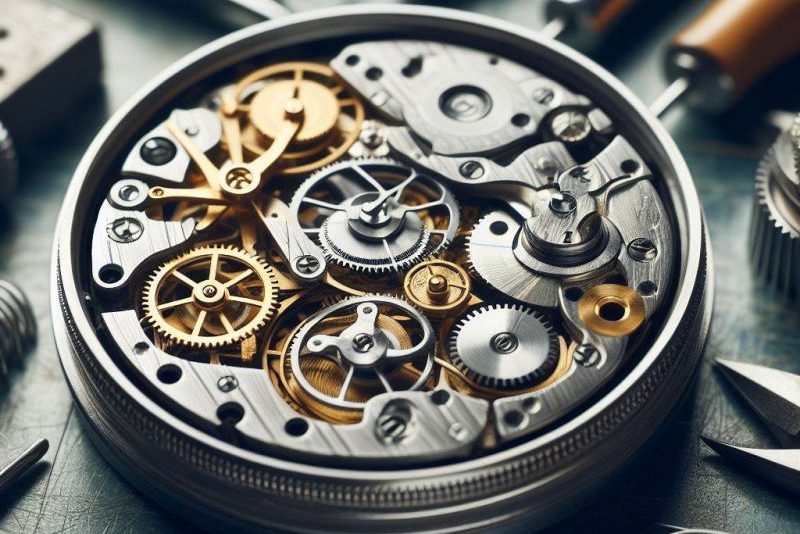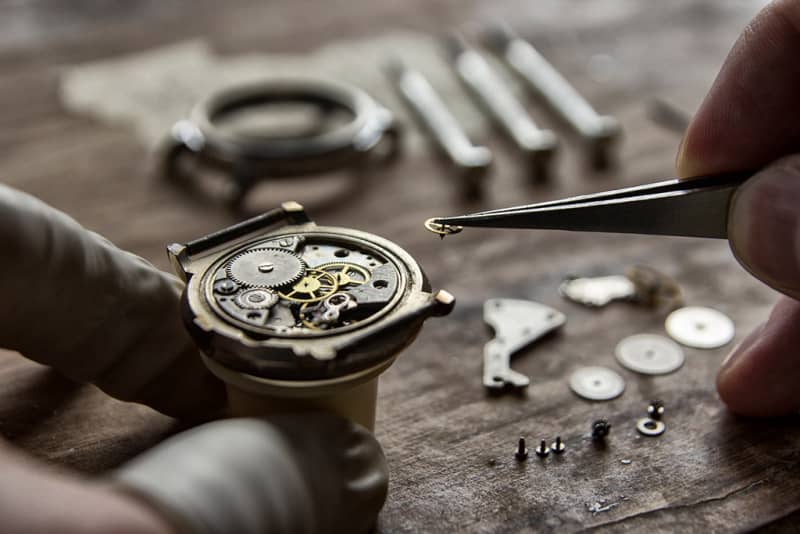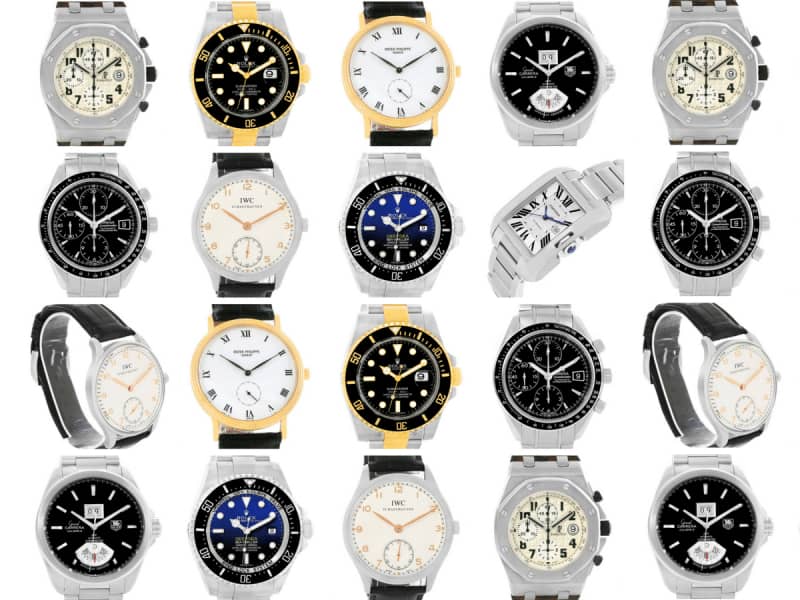The watch movement is one of the most important aspects of a luxury timepiece.
It is what determines the watch’s accuracy and how well it keeps time. movements are classified according to their level of precision.
The most accurate watches have a movement that is classified as a “chronometer.”
Yes, watch movement has a lot to do with the watch’s accuracy, but it also plays a big role in the watch’s value.
A watch with a high-quality movement is considered to be more valuable than one with an inferior movement.
This is because higher-quality watch movements are made from better components and materials, which often cost more money.
In this blog post, we will discuss the different types of watch movements, common types of watch movements used in luxury watches, the price and value of each different watch movement, and the list of common watch movement brands.

Manual, automatic, and quartz are the three main types of luxury watch movements. The first two are examples of mechanical movement. While the second one is all electric.
In general, mechanical watches are more expensive because they require a lot of work to make.
Also, many people like this kind of watch because it has a long history. It’s the result of years of new ideas in the watch business. And, because of this, has emotional value.
When it comes to quartz watch movements, they are very precise. This makes it possible to keep a very accurate time.
Also, watches with quartz movements tend to be less expensive and more common because of this.
Now that you know the different kinds of watch movements, let’s look at each one in more depth.
The earliest mechanical movement, manual, is a time-honored way of winding watches. Dating from the 16th century.
In 1510, German clockmaker Peter Henlein developed the first mechanical watch. However, it bore little resemblance to current manual wristwatches. It had to be worn around the neck or on a belt at first.
Fast forward to 1676, when Daniel Quare invents the minute hand. Introducing a new degree of precision to manual watches.
Because of industrialization, the large manufacture of manual timepieces became feasible by the 1900s. This might be considered the formal beginning of the watch business since the innovation gained popularity.
Manual movement watches need the user to wind the watch on a regular basis. Ideally, once each day.
Winding manual watches involves winding the stem and crown, which power the mainspring.
This power lasts longer in manual watches than in automatic timepieces. That’s why it’s important to wind the watch every day.
So, what is it that makes certain individuals prefer manual movement?
For starters, a manual watch’s mechanism is simpler than that of an automatic watch. Because there are fewer moving components.
A manual watch, for example, does not need a motor. As a consequence, this sort of watch is less expensive and requires less care in terms of repairs.
Furthermore, many watch enthusiasts appreciate the aesthetics of manual watches, which allow you to see the working elements within the watch. In reality, many antiques include manual movement to give them a vintage appearance.
Manual movements have some disadvantages. For example, timekeeping is not always accurate; there may be small differences.
Furthermore, due to the low battery reserve, a manual watch may stop abruptly.
Finally, some individuals consider manual watches to be a nuisance since they need daily care in the form of winding the watch.
For the mainspring to wind and potential energy to be stored, the user must spin the crown many times.
will progressively unwind and release energy via a sequence of gears and springs that govern energy release.
This energy is then transmitted to the watch hands, which revolve and power the complexities.
While automated movement falls into the same mechanical category as manual movement, the extra motor radically changes the operation.
In 1776, Abraham-Louis Perrelet is thought to have made the first automatic watch.
The Swiss church elder had begun a watch industry revolution that would lead to the mainstream manufacturing of self-winding timepieces. However, he did not have much success at the time because many thought his automated watch was too costly.
The Englishman John Hardwood invented the first wristwatch with an automated mechanism in 1924. This style of the watch was quite similar to the ones we see now.
The rotor is crucial in automated movement. The movement of the wrist activates the rotor, which winds the barrel and mainspring. As a result of being basically self-winding, automatic watches have an exceptional power reserve.
If you wear your automatic watch often, the rotor will be able to detect wrist movement. If you don’t wear it often, you will need to wind it up like a manual watch.
Automatic watches have seized the market by storm. It is undeniable that they acquire more watches than their manual counterparts.
They effectively blend the classic look of manual watches with the ease of quartz watches to create a product that is both traditional and contemporary.
While automatic watches are quite accurate, quartz watches come out on top in this area.
Similarly, quartz movements have an outstanding power reserve. Automatic watches cannot compete since they still need winding every now and then.
An automated movement functions similarly to a manual movement, with the addition of a metal weight known as a rotor.
The rotor is linked to the movement and may freely revolve. The rotor rotates with each wrist movement, transferring energy and winding the mainspring automatically.
Finally, but not least, we have quartz movement.
Because of its low cost and simplicity of mass manufacture, this form of movement has grown in popularity. It is often linked with high-end watch brands.
The watch industry experienced a period of rapid change in 1969. Upon its release, the Seiko Quartz Astron 35SQ, the first quartz wristwatch, received widespread praise for its precision. Despite the fact that its vast size was a potential disadvantage.
The quartz movement is the most basic of the three. The engine is powered by a battery, and the hand ticks at a precise pace thanks to a quartz crystal.
To be more specific, the battery sends an electric signal via the quartz, which causes vibrations.
Quartz watches are unquestionably better in terms of timekeeping accuracy. We can expect a quartz movement watch to be very exact since we are not dependent on ourselves to wind the mechanism.
Furthermore, the independence from having to wind the watch is ideal for the low-maintenance among us.
In general, quartz movement watches are the most budget-friendly option. They are not only less expensive owing to the low-intensity production method, but they are also more durable.
Because a quartz movement watch has fewer moving parts, there is less likelihood that a component may break and need maintenance.
With batteries that last many years, quartz movement watches are unquestionably cost-effective.
Quartz movements are used in inexpensive everyday watches because they are easy to maintain and use a battery as their primary power source.
In quartz watch movements, a tiny quartz crystal is electrified by an electrical current from a battery, which then causes vibrations.
The watch hands are powered by a motor, which is driven by the movement’s oscillations.

As watch technology has evolved, so too have the watch movements that power them.
There are three primary types of watch movement: manual, automatic, and quartz.
Each has its own advantages and disadvantages in terms of price difference and value.
Manual watch movements are those that must be wound by hand on a regular basis in order to keep time.
Manual watches also have a smaller power reserve than either automatic or quartz watches. As a result, they are not as popular as automatic watches and can be more expensive.
However, they offer a unique experience that is not found in other types of watch movements.
Automatic watch movement relies on the movement of the wearer’s arm to wind the watch’s mainspring.
They do not need to be wound as often as manual watches, but they do require more maintenance overall because the rotor needs to be cleaned regularly to prevent it from rusting.
Automatic watches also tend to be less accurate than quartz watches. However, they offer a classic look and feel that is unmatched by any other type of watch movement.
Additionally, because they are powered by kinetic energy instead of batteries, automatic watches typically have a longer lifespan than quartz watch movements.
The quartz watch movement is the simplest and most common type of watch movement.
It uses an electrical signal to power the watch and is known for its accuracy.
The quartz watch movement has been around since the 1960s and is still used today in many watch models.
Quartz watch movements are typically more affordable than automatic or manual watch movements, making them a popular choice for those who want an elegant watch at a reasonable price.
The quartz watch movement is also known for its low maintenance requirements and long battery life, making it an ideal choice for those who don’t want to worry about winding their watch or replacing batteries.
When it comes to pricing and value, quartz watch movements are generally the least expensive watch movement type.
This makes them a great choice for those who want an attractive watch at an affordable price.
List of Common Watch Movements Brands
ETA is widely recognized as the greatest watch movement maker in the world, and it is the biggest producer of completed and semi-finished movements in the world.
The end of the 18th century is a possible starting point for its history.
Mechanical and quartz timepieces are special to ETA. ETA was created when many different movement manufacturers, including Adolf Schild (AS), Valjoux, Unitas, etc., became one company.
Now that it is a part of the Swatch Group, ETA has become the world’s leading maker of watch movements.
Soprod was also an ETA foundry maker. They excel at cleaning things up, plating them, swapping out expensive components, and adding functioning modules. Additionally, this firm depends critically on ETA.
Their current featured movement, the A10, is a simple movement that differs from the ETA and Sellita in terms of the balance and the gadget used to fine-tune the movement.
As a result, it is immediately recognizable thanks to its distinctive appearance.
Since ETA 2892 is the primary target for A10, that grade is the focus. ETA’s Top standards are strictly adhered to in the creation of all A10 movements.
The name “Seiko” refers to a whole group of companies that started with the watch business started by the Hattori family in the late 1800s.
Having said that, the subsidiaries are diverse and, in many instances, managed autonomously.
TMI – Time Module – is a relatively unknown Seiko subsidiary.
Time Module sells Seiko movements to other parties, frequently under aliases that make particular identification impossible.
Because of its price and dependability, the TMI NH series of movements can be found in a number of iconic Seiko diving watches and is extensively utilized by numerous watchmakers.
Ops also sells custom watches with NH movements. The price is the same as micro brands, but the quality is just as good.
RONDA, famed for its trustworthy Swiss quartz movements, released a new mechanical movement in 2016.
Their long history, dating back to 1946, as a manufacturer that strives to make only the greatest and most precise movements in the business, and their affiliations with so many industry leaders, suggest they must be doing something right.
Seagull is a Tianjing-based Chinese movement producer. Since 1955, it has been producing watches and watches parts.
Since the success of the Seagull 1963 chronograph watch, which is powered by its ST 19 movement, many other watch manufacturers have begun utilizing it.
Sellita was created in 1950 and used to be a foundry for ETA movements until beginning to build its own movements in 2003.
Because of the ties with ETA, Sellita’s SW movement is essentially a “clone” of the ETA movement.
There are five series and hundreds of models in Sellita’s movement, but there are three primary models: SW200 emulating ETA2824, SW300 imitating ETA2892, and SW500 imitating ETA7750.
Some watchmakers have different models of watches that use either an ETA movement or a Sellita movement, depending on which one is available at the time.
The Citizen Miyota Co., Ltd. is a subsidiary of Citizen and a major watch movement producer.
Produced by the millions every year, Miyota motions can be found almost everywhere.
The 9000 series movements are Japan’s response to the tried-and-true Swiss ETA 2824-2 and its ilk, and they outperform their Swiss counterparts in terms of precision and durability.
Its slim profile compared to other automatic movements allows for a more elegant and refined design in the finished watch.
Miyota’s movements may be found in watches from Fossil, Orient, Casio, and DW, to name a few.
The intricate mechanism of each watch is a work of art. Every luxury watch has its level of craftsmanship and quality. Each is created artistically by expert watchmakers making the timepiece have an elegant design and accurate timekeeping. But, luxury watch collectors prefer mechanical or automatic movements. Let yourself fall into one of the types of a watch movement and share your ideas below if you have different insight!

Copyright © 2018 Sofly Limited



Leave a Reply
Your email address will not be published. Required fields are marked *